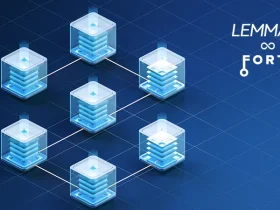Trust, security, and transparency in transactions have become major concerns in today’s digital world. Traditional centralized systems often suffer from vulnerabilities, lack of transparency, and the need for intermediaries, leading to inefficiencies and potential risks. However, blockchain technology has emerged as a groundbreaking solution to these problems. According to Statista, the worldwide blockchain technology market is predicted to increase in the next years, reaching a valuation of over $39 billion by 2025. Let’s learn everything about this billion-dollar industry.
What is Blockchain Technology?
Blockchain technology is an innovative database system enabling transparent information sharing among business networks. It organizes data into linked blocks, ensuring chronological consistency and immutability. With built-in security measures, blockchain facilitates reliable tracking of orders, payments, and transactions while preventing unauthorized alterations.
Different Types of Blockchain Technology
 Blockchain technology comes in various types, each serving distinct purposes:
Blockchain technology comes in various types, each serving distinct purposes:
- Public Blockchain: Open to everyone, allowing anyone to participate, verify transactions, and maintain the network. Examples include Bitcoin and Ethereum.
- Private Blockchain: Restricted access, typically used within organizations or specific groups, offering higher privacy and control over data.
- Consortium Blockchain: Controlled by a group of organizations, sharing responsibilities in managing the network, offering a balance between decentralization and control.
- Hybrid Blockchain: Combines elements of both public and private blockchains, offering flexibility in terms of privacy, control, and scalability.
- Permissioned Blockchain: Requires permission to join the network, offering increased security and efficiency compared to public blockchains.
These variations cater to different needs, ranging from open and decentralized networks to closed and controlled environments, providing solutions for diverse industries and use cases.
Also Read: Top 5 Blockchain Startup Ideas That You Need to Invest in 2024
Significance of Blockchain Explained
Conventional database systems pose numerous obstacles when it comes to documenting financial dealings. Take, for instance, the scenario of selling a property. Upon the transaction of funds, the property’s ownership shifts to the purchaser. While each party, the buyer and the seller, can document the financial transactions independently, neither record can be deemed reliable. The seller may falsely assert not receiving the payment, even after having done so, while the buyer could claim to have made the payment despite not having actually done so.
A credible external party must oversee and verify transactions to prevent legal complications. However, the existence of such central oversight not only adds complexity to transactions but also introduces a single point of weakness. Should the central database be compromised, adverse consequences could be experienced by both involved parties.
Rephrase Blockchain addresses these challenges by establishing a decentralized and secure network to document transactions. For instance, in real estate transactions, blockchain generates separate ledgers for buyers and sellers. Every transaction necessitates mutual consent and reflects simultaneously on both ledgers. If there’s any alteration in past transactions, it impacts the entire ledger. The characteristics of blockchain have facilitated its adoption across diverse industries, including the emergence of virtual currencies such as Bitcoin.
What are the Benefits of Blockchain Technology?
 Below are some of the key advantages:
Below are some of the key advantages:
- Enhanced Security: With its decentralized structure and cryptographic safeguards, blockchain ensures secure and tamper-proof transactions, guarding against unauthorized alterations.
- Improved Transparency: Through its distributed ledger, blockchain grants all participants visibility into transactions, fostering transparency and trust with a clear and auditable history.
- Efficiency and Speed: By cutting out intermediaries and streamlining processes, blockchain facilitates faster and more efficient transactions, automating tasks, and reducing paperwork.
- Cost Savings: Eliminating intermediaries reduces transaction costs and the risk of fraud, translating into significant savings for businesses.
- Improved Traceability: Blockchain’s transparency allows for better asset and transaction traceability, proving invaluable for supply chain management and provenance verification.
- Decentralization: Operating on a decentralized network enhances resilience and robustness, minimizing the risk of system failures.
- Smart Contracts: Blockchain enables self-executing smart contracts, automating agreement enforcement, and ensuring transparency in contractual dealings.
- Data Integrity: Once recorded, data on the blockchain remains immutable, safeguarding its integrity and minimizing the risk of manipulation.
- Cross-Border Transactions: Simplifying cross-border transactions by eliminating intermediaries, blockchain enhances efficiency and reduces costs.
- Innovation and Disruption: By enabling new business models and decentralized applications, blockchain fuels innovation and promises transformative opportunities across industries.
What is the Application of Blockchain Technology?
Some noteworthy examples include:
Cryptocurrencies such as Bitcoin and Ethereum operate on blockchain, which serves as the underlying mechanism for secure and decentralized digital transactions, guaranteeing safe peer-to-peer exchanges.
Blockchain technology has transformative potential to enhance transparency and traceability in supply chains. This innovation streamlines the tracking of goods, validates authenticity, and mitigates fraudulent activities, revolutionizing supply chain management while ensuring accountability across all stages.
Blockchain has the potential to transform healthcare by bolstering data security and patient privacy, streamlining medical records, enabling secure health information sharing, and improving drug traceability.
Blockchain possesses the transformative ability to revolutionize various financial operations.
Blockchain simplifies the real estate offering by providing avenues for property transactions, expedited title transfers, and the novel concept of fractional ownership. These advancements not only enhance the efficiency of real estate dealings but also boost transparency, revolutionizing the sector’s operational landscape.
Blockchain emerges as a transformative force in optimizing supply chain and logistics operations, revolutionizing processes, fostering transparency, and slashing paperwork burdens. These advancements provide a seamless, fortified movement of goods across the supply chain landscape.
Blockchain technology plays a crucial role in revolutionizing voting processes and governance. By leveraging blockchain, organizations can implement secure and transparent voting systems, uphold election integrity, and optimize governance efficiency.
Also Read: What is UCaaS and Why Does it Matter?
How Does Blockchain Technology Work?
Blockchain operates through a series of key components and processes:
Decentralized Network: Utilizing a network of computers (nodes), blockchain ensures each node holds a copy of the ledger, fostering decentralization and resilience.
Blocks and Transactions: Transactions are grouped into blocks, each containing verified and timestamped transactions, forming a sequential chain.
Cryptographic algorithms secure data within blocks, with each block possessing a unique hash based on its content, ensuring tamper-evident integrity.
Consensus Mechanism: Various consensus algorithms, like Proof of Work (PoW) or Proof of Stake (PoS), validate and add new blocks, ensuring agreement among network participants.
Validation and Verification: Nodes validate transactions by checking authenticity, fund availability, and adherence to predefined rules before adding them to a new block.
Block Addition: Validated blocks are added to the blockchain by linking to the previous block, creating an immutable and chronological record of transactions.
Distributed Ledger: The ledger is distributed across all nodes, ensuring transparency and eliminating the need for a central authority while maintaining identical copies of the blockchain across the network.
What is the Purpose of Blockchain Technology?
Blockchain technology serves various purposes, each contributing to its power and versatility:
- Security: Utilizing cryptographic algorithms, blockchain safeguards transactions against unauthorized modifications and tampering, ensuring data integrity.
- Transparency: Through its distributed ledger, blockchain offers visibility into transactions for all participants, fostering trust and eliminating the need for intermediaries.
- Decentralization: Operating on a decentralized network, blockchain enhances resilience, reduces the risk of a single point of failure, and strengthens the overall robustness of the system.
- Efficiency: By cutting out intermediaries and streamlining processes, blockchain enables faster and more efficient transactions, automating tasks, and accelerating data transfer.
- Trust: With its immutable and transparent record, blockchain enhances trust by ensuring the integrity of transactions, and bolstering confidence among participants.
- Cost Savings: Eliminating intermediaries reduces transaction costs and the risk of fraud, resulting in significant cost savings for businesses.
- Innovation: Blockchain fosters innovation by enabling new business models, decentralized applications, and peer-to-peer transactions, opening up opportunities for smart contracts and decentralized services.
These features make blockchain an invaluable tool for industries seeking enhanced security, transparency, efficiency, trust, and innovation in their operations.
End Note
Blockchain technology presents a transformative solution to the challenges of trust, security, and transparency in various industries. With its decentralized network, cryptographic algorithms, and distributed ledger, blockchain offers a secure and transparent platform for recording and verifying transactions. By eliminating the need for intermediaries, blockchain enhances efficiency, reduces costs, and fosters innovation.

































